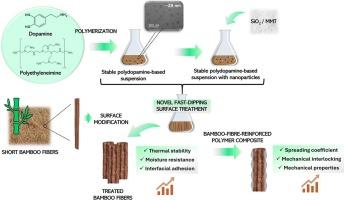Stable polydopamine-based suspension for scalable surface modification of bamboo fibre–reinforced composites
IF 8.1
2区 材料科学
Q1 ENGINEERING, MANUFACTURING
Composites Part A: Applied Science and Manufacturing
Pub Date : 2025-07-24
DOI:10.1016/j.compositesa.2025.109206
引用次数: 0
Abstract
This study investigates the effect of surface modifications on bamboo fibre (BF)-reinforced polypropylene (PP) composites (BF/PP) using polydopamine (PDA), polyethyleneimine (PEI), and nanoparticles such as silicon dioxide (SiO2) and montmorillonite (MMT). Treatments were designed to enhance three critical properties: moisture resistance, thermal stability, and fibre–matrix adhesion. A novel, fast dipping treatment using PDA stabilized with PEI (P/PE) was developed as a scalable alternative to conventional in-situ PDA polymerization. BFs were treated via dopamine polymerization (4 h and 24 h, with and without PEI) and a fast immersion process with P/PE suspension applied for 300 s (referred to as P/PE-300) with and without nanoparticles. Surface characterization, including X-ray photoelectron spectroscopy (XPS), Fourier-transform infrared (FTIR) and Atomic Force Microscopy (AFM), confirmed fibre coating across all treatments. Treatments including SiO2 and MMT nanoparticles reduced the equilibrium moisture content of BFs by 15 % and 11 %, respectively, and improved the onset temperature of thermal degradation (Tonset) under nitrogen atmosphere. Wettability tests showed that the P/PE-300 treatment improved the spreading coefficient, promoting better polymer impregnation. Apparent interfacial shear strength (IFSS) increased by 19 % with P/PE-300, while the addition of nanoparticles further enhanced IFSS by 32 %, attributed to mechanical interlocking. Composites with P/PE-300 treated BFs exhibited a 17 % increase in tensile strength and a 19 % improvement in flexural strength compared to untreated composites, driven by enhanced interfacial adhesion confirmed by micro-computed tomography (µCT). These findings highlight the potential of PDA-based suspensions for advancing sustainable, scalable composite production with enhanced fibre–matrix performance.

稳定的聚多巴胺悬浮液用于竹纤维增强复合材料的可伸缩表面改性
本文研究了用聚多巴胺(PDA)、聚乙烯亚胺(PEI)和二氧化硅(SiO2)、蒙脱土(MMT)等纳米颗粒对竹纤维(BF)-增强聚丙烯(PP)复合材料(BF/PP)进行表面改性的效果。处理旨在提高三个关键性能:防潮性,热稳定性和纤维基质粘附性。利用PEI (P/PE)稳定PDA,开发了一种新型的快速浸渍处理方法,可替代传统的原位PDA聚合。通过多巴胺聚合(4 h和24 h,有和没有PEI)和P/PE悬浮液快速浸泡300 s(简称P/PE-300)处理BFs,有和没有纳米颗粒。表面表征,包括x射线光电子能谱(XPS),傅里叶变换红外(FTIR)和原子力显微镜(AFM),证实了所有处理的纤维涂层。SiO2和MMT纳米颗粒处理分别使BFs的平衡水分含量降低了15%和11%,并提高了氮气氛下热降解的起始温度(Tonset)。润湿性试验表明,P/PE-300处理提高了扩散系数,促进了聚合物的浸渍。P/PE-300的表观界面剪切强度(IFSS)提高了19%,而纳米颗粒的加入进一步提高了32%,这是由于机械联锁。微计算机断层扫描(µCT)证实,与未经处理的复合材料相比,经过P/PE-300处理的复合材料的拉伸强度提高了17%,弯曲强度提高了19%。这些发现强调了基于pda的悬浮液在促进可持续、可扩展的复合材料生产方面的潜力,同时增强了纤维基质的性能。
本文章由计算机程序翻译,如有差异,请以英文原文为准。
求助全文
约1分钟内获得全文
求助全文
来源期刊

Composites Part A: Applied Science and Manufacturing
工程技术-材料科学:复合
CiteScore
15.20
自引率
5.70%
发文量
492
审稿时长
30 days
期刊介绍:
Composites Part A: Applied Science and Manufacturing is a comprehensive journal that publishes original research papers, review articles, case studies, short communications, and letters covering various aspects of composite materials science and technology. This includes fibrous and particulate reinforcements in polymeric, metallic, and ceramic matrices, as well as 'natural' composites like wood and biological materials. The journal addresses topics such as properties, design, and manufacture of reinforcing fibers and particles, novel architectures and concepts, multifunctional composites, advancements in fabrication and processing, manufacturing science, process modeling, experimental mechanics, microstructural characterization, interfaces, prediction and measurement of mechanical, physical, and chemical behavior, and performance in service. Additionally, articles on economic and commercial aspects, design, and case studies are welcomed. All submissions undergo rigorous peer review to ensure they contribute significantly and innovatively, maintaining high standards for content and presentation. The editorial team aims to expedite the review process for prompt publication.
 求助内容:
求助内容: 应助结果提醒方式:
应助结果提醒方式:


